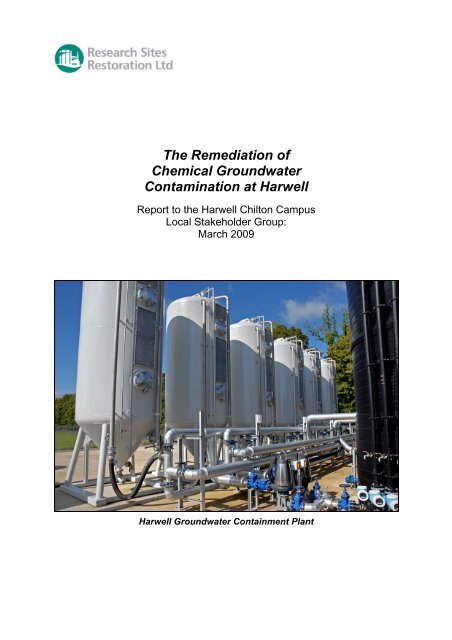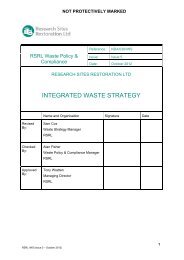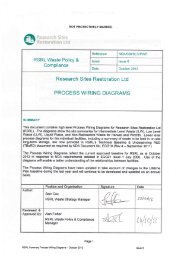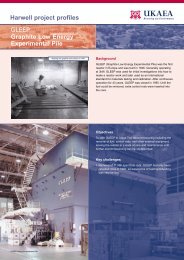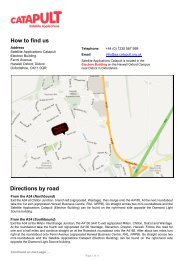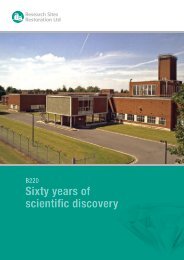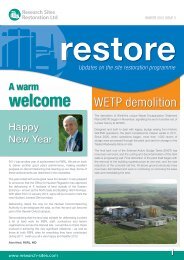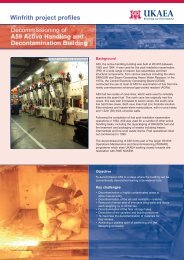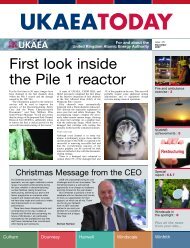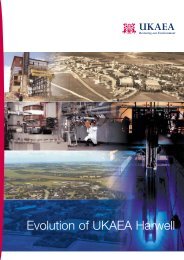The Remediation of Chemical Groundwater Contamination at Harwell
The Remediation of Chemical Groundwater Contamination at Harwell
The Remediation of Chemical Groundwater Contamination at Harwell
You also want an ePaper? Increase the reach of your titles
YUMPU automatically turns print PDFs into web optimized ePapers that Google loves.
<strong>The</strong> <strong>Remedi<strong>at</strong>ion</strong> <strong>of</strong><strong>Chemical</strong> <strong>Groundw<strong>at</strong>er</strong><strong>Contamin<strong>at</strong>ion</strong> <strong>at</strong> <strong>Harwell</strong>Report to the <strong>Harwell</strong> Chilton CampusLocal Stakeholder Group:March 2009<strong>Harwell</strong> <strong>Groundw<strong>at</strong>er</strong> Containment Plant
<strong>The</strong> <strong>Remedi<strong>at</strong>ion</strong> <strong>of</strong> <strong>Chemical</strong> <strong>Groundw<strong>at</strong>er</strong> <strong>Contamin<strong>at</strong>ion</strong> <strong>at</strong> <strong>Harwell</strong>LSG <strong>Groundw<strong>at</strong>er</strong> Report ii March 2009
<strong>The</strong> <strong>Remedi<strong>at</strong>ion</strong> <strong>of</strong> <strong>Chemical</strong> <strong>Groundw<strong>at</strong>er</strong> <strong>Contamin<strong>at</strong>ion</strong> <strong>at</strong> <strong>Harwell</strong>THE REMEDIATION OF CHEMICAL GROUNDWATERCONTAMINATION AT HARWELLIssue D<strong>at</strong>e Author Checked by Approved byA March 09 Name Jon Blackmore Paul Atyeo Ken HeiderRole Project Manager Senior Project Closure DirectorManagerSign<strong>at</strong>ureD<strong>at</strong>eLSG <strong>Groundw<strong>at</strong>er</strong> Report iii March 2009
<strong>The</strong> <strong>Remedi<strong>at</strong>ion</strong> <strong>of</strong> <strong>Chemical</strong> <strong>Groundw<strong>at</strong>er</strong> <strong>Contamin<strong>at</strong>ion</strong> <strong>at</strong> <strong>Harwell</strong>LSG <strong>Groundw<strong>at</strong>er</strong> Report iv March 2009
<strong>The</strong> <strong>Remedi<strong>at</strong>ion</strong> <strong>of</strong> <strong>Chemical</strong> <strong>Groundw<strong>at</strong>er</strong> <strong>Contamin<strong>at</strong>ion</strong> <strong>at</strong> <strong>Harwell</strong>EXECUTIVE SUMMARY<strong>Chemical</strong> contamin<strong>at</strong>ion <strong>of</strong> groundw<strong>at</strong>er <strong>at</strong> <strong>Harwell</strong> was first identified in the l<strong>at</strong>e1980s. This contamin<strong>at</strong>ion, principally by chlorin<strong>at</strong>ed organic chemicals, wassubsequently linked to the disposal <strong>of</strong> waste chemicals in unlined chalk pits <strong>at</strong><strong>Harwell</strong>. <strong>The</strong>se waste disposal pits were loc<strong>at</strong>ed <strong>at</strong> the Southern Storage Area(SSA), formerly used by the RAF for munitions storage, and the Western StorageArea (WSA). RSRL has subsequently undertaken a major programme <strong>of</strong> work toinvestig<strong>at</strong>e and deal with the contamin<strong>at</strong>ion. This report presents developments inrel<strong>at</strong>ion to the groundw<strong>at</strong>er programme <strong>at</strong> <strong>Harwell</strong> during 2008.<strong>The</strong> groundw<strong>at</strong>er containment plant (HGCP) continues to maintain effective hydrauliccontainment <strong>at</strong> the WSA. This was confirmed by the w<strong>at</strong>er level measurements madeduring 2008.HGCP has realised improvements over the original plant in terms <strong>of</strong> health andsafety, energy consumption, waste gener<strong>at</strong>ion and ease and flexibility <strong>of</strong> oper<strong>at</strong>ion.Energy consumption is 30% <strong>of</strong> th<strong>at</strong> used by the old groundw<strong>at</strong>er plant.<strong>Remedi<strong>at</strong>ion</strong> <strong>of</strong> the uns<strong>at</strong>ur<strong>at</strong>ed zone <strong>at</strong> the WSA has continued during 2008,removing a further 795 kg <strong>of</strong> contaminants. <strong>The</strong> total removed by the uns<strong>at</strong>ur<strong>at</strong>edzone project is now nearly 1.8 tonnes. Up to three further phases <strong>of</strong> uns<strong>at</strong>ur<strong>at</strong>edzone remedi<strong>at</strong>ion are planned.<strong>The</strong> total mass <strong>of</strong> contamin<strong>at</strong>ion removed by the different components <strong>of</strong> theremedi<strong>at</strong>ion programme is now estim<strong>at</strong>ed to be approxim<strong>at</strong>ely 11 tonnes.LSG <strong>Groundw<strong>at</strong>er</strong> Report v March 2009
<strong>The</strong> <strong>Remedi<strong>at</strong>ion</strong> <strong>of</strong> <strong>Chemical</strong> <strong>Groundw<strong>at</strong>er</strong> <strong>Contamin<strong>at</strong>ion</strong> <strong>at</strong> <strong>Harwell</strong>GLOSSARYAODAquiferBoreholeChlorin<strong>at</strong>edsolventsGAC<strong>Groundw<strong>at</strong>er</strong>LevelHGCP<strong>Remedi<strong>at</strong>ion</strong>SSASVETEVEUns<strong>at</strong>ur<strong>at</strong>edzoneVacuumextractionVOCsW<strong>at</strong>er TableWSAZone <strong>of</strong>w<strong>at</strong>er tablefluctu<strong>at</strong>ionAbove Ordnance D<strong>at</strong>um. <strong>The</strong> height <strong>of</strong> a point (eg the w<strong>at</strong>er table or groundlevel) above mean sea level (the Newlyn d<strong>at</strong>um, since 1921), usually expressedin metres (eg 120 m AOD).An aquifer is a permeable rock th<strong>at</strong> stores and allows groundw<strong>at</strong>er flow readilythrough it.A deep, narrow vertical shaft used for the extraction or monitoring <strong>of</strong> groundw<strong>at</strong>eror soil vapour. Typically, boreholes drilled <strong>at</strong> <strong>Harwell</strong> in rel<strong>at</strong>ion to the chemicalgroundw<strong>at</strong>er contamin<strong>at</strong>ion programme are between 50 and 200 mm in diameterand up to 55 metres deep.Liquids used to remove grease from metal components in engineering workshopsand also as labor<strong>at</strong>ory reagents. <strong>The</strong>se were disposed <strong>of</strong> in large quantities to thewaste pits <strong>at</strong> the SSA and WSA. <strong>The</strong> principal groundw<strong>at</strong>er contaminants are allchlorin<strong>at</strong>ed solvents:• carbon tetrachloride;• chlor<strong>of</strong>orm;• 1,1,1-trichloroethane;• trichloroethene; and• tetrachloroethene.Chlorin<strong>at</strong>ed solvents form part <strong>of</strong> a larger grouping <strong>of</strong> chemicals called VOCs(see below).Granular Activ<strong>at</strong>ed Carbon. A product <strong>of</strong>ten derived from coal or coconut husks,which readily adsorbs organic chemicals. Widely used in many industries for thetre<strong>at</strong>ment <strong>of</strong> contamin<strong>at</strong>ed liquids and gases.See W<strong>at</strong>er Table.<strong>Harwell</strong> <strong>Groundw<strong>at</strong>er</strong> Containment Plant – the replacement w<strong>at</strong>er tre<strong>at</strong>ment plant<strong>at</strong> the WSA, which became fully oper<strong>at</strong>ional in June 2007.In the context <strong>of</strong> pollution, used to describe works carried out to reduce theimpact <strong>of</strong> the pollution.Southern Storage Area. <strong>The</strong> former RAF bomb dump, used for wastemanagement and disposal oper<strong>at</strong>ions by UKAEA from the 1940s to the 1970s.Soil Vapour Extraction. A technique used for removing VOC contamin<strong>at</strong>ion fromsoils and rocks, usually above the w<strong>at</strong>er table.<strong>The</strong>rmally enhanced vacuum extraction. Collective term for a group <strong>of</strong> techniqueswhich use he<strong>at</strong> energy to improve the r<strong>at</strong>e <strong>of</strong> contaminant removal using SVE. Inthe case <strong>of</strong> the WSA project, conductive he<strong>at</strong>ing elements are used to he<strong>at</strong> thechalk above the w<strong>at</strong>er table.<strong>The</strong> part <strong>of</strong> the aquifer above the w<strong>at</strong>er table.See SVE.Vol<strong>at</strong>ile Organic Compounds. A broad grouping for a range <strong>of</strong> different organiccompounds characterised by their readiness to evapor<strong>at</strong>e under normalconditions. Many <strong>of</strong> the chlorin<strong>at</strong>ed solvents fall within this c<strong>at</strong>egory.Th<strong>at</strong> level bene<strong>at</strong>h the land <strong>at</strong> which the pores <strong>of</strong> rock or soil become completelyfull <strong>of</strong> groundw<strong>at</strong>er. Also referred to as the groundw<strong>at</strong>er level.Western Storage Area. Licensed landfill, used for the disposal <strong>of</strong> chemical wastesfrom the 1970s to 1980s.<strong>The</strong> part <strong>of</strong> the chalk th<strong>at</strong> is between the lowest and highest observed w<strong>at</strong>er tablelevels. At <strong>Harwell</strong>, the Chalk w<strong>at</strong>er table fluctu<strong>at</strong>es by up to 18 metres, from thelowest to highest levels. Depending on the elev<strong>at</strong>ion <strong>of</strong> the w<strong>at</strong>er table, this part<strong>of</strong> the aquifer may be available for SVE or TEVE.LSG <strong>Groundw<strong>at</strong>er</strong> Report vi March 2009
<strong>The</strong> <strong>Remedi<strong>at</strong>ion</strong> <strong>of</strong> <strong>Chemical</strong> <strong>Groundw<strong>at</strong>er</strong> <strong>Contamin<strong>at</strong>ion</strong> <strong>at</strong> <strong>Harwell</strong>CONTENTSEXECUTIVE SUMMARY............................................................................................ 5Glossary ..................................................................................................................... 61 Introduction.......................................................................................................... 12 <strong>Groundw<strong>at</strong>er</strong> Levels ............................................................................................ 33 <strong>Groundw<strong>at</strong>er</strong> Containment, Western Storage Area ............................................. 64 Uns<strong>at</strong>ur<strong>at</strong>ed Zone <strong>Remedi<strong>at</strong>ion</strong>, WSA............................................................... 105 <strong>Groundw<strong>at</strong>er</strong> Monitoring.................................................................................... 126 Summary ........................................................................................................... 15FiguresFigure 1 Loc<strong>at</strong>ion <strong>of</strong> the Western and Southern Storage Areas <strong>at</strong> <strong>Harwell</strong> ................ 2Figure 2 Geological map <strong>of</strong> the <strong>Harwell</strong> Area ............................................................. 2Figure 3 <strong>Groundw<strong>at</strong>er</strong> levels (“w<strong>at</strong>er table”) in the Chalk <strong>at</strong> <strong>Harwell</strong> (Borehole HWS9),1991 to 2009 ................................................................................................ 4Figure 4 Annual vari<strong>at</strong>ion in groundw<strong>at</strong>er levels in Borehole HWS9 during 2007 and2008 in comparison to d<strong>at</strong>a since 1991........................................................ 4Figure 5 Map <strong>of</strong> <strong>Harwell</strong> site showing groundw<strong>at</strong>er levels and groundw<strong>at</strong>er flowdirections in the Chalk aquifer, April & October 2008................................... 5Figure 6 Schem<strong>at</strong>ic represent<strong>at</strong>ion <strong>of</strong> the hydraulic containment <strong>of</strong> groundw<strong>at</strong>ercontamin<strong>at</strong>ion <strong>at</strong> the Western Storage Area................................................. 6Figure 7 Annual quantities <strong>of</strong> groundw<strong>at</strong>er tre<strong>at</strong>ed and contaminant mass removedby the Western <strong>Groundw<strong>at</strong>er</strong> Plant .............................................................. 9Figure 8 Total contaminant concentr<strong>at</strong>ions in the w<strong>at</strong>er pumped into the Western<strong>Groundw<strong>at</strong>er</strong> Plant ....................................................................................... 9Figure 9 Illustr<strong>at</strong>ion <strong>of</strong> remedi<strong>at</strong>ion techniques for the uns<strong>at</strong>ur<strong>at</strong>ed zone and zone <strong>of</strong>w<strong>at</strong>er table fluctu<strong>at</strong>ion <strong>at</strong> the Western Storage Area .................................. 11Figure 10 Install<strong>at</strong>ion <strong>of</strong> conductive he<strong>at</strong>ing elements in boreholes for the TEVEsystem........................................................................................................ 11Figure 11 Total contaminant concentr<strong>at</strong>ions (CHCs - chlorin<strong>at</strong>ed hydrocarbons),April and October 2008 .............................................................................. 13Figure 12 Vari<strong>at</strong>ion in total contaminant concentr<strong>at</strong>ion with time in boreholeHWS1 (150 metres north <strong>of</strong> the WSA) ....................................................... 14Figure 13 Vari<strong>at</strong>ion in total contaminant concentr<strong>at</strong>ion with time in boreholeHWS10 (200 metres southeast <strong>of</strong> the WSA) .............................................. 14Figure 14 Summary <strong>of</strong> contaminant mass removal by year ................................ 15LSG <strong>Groundw<strong>at</strong>er</strong> Report vii March 2009
<strong>The</strong> <strong>Remedi<strong>at</strong>ion</strong> <strong>of</strong> <strong>Chemical</strong> <strong>Groundw<strong>at</strong>er</strong> <strong>Contamin<strong>at</strong>ion</strong> <strong>at</strong> <strong>Harwell</strong>LSG <strong>Groundw<strong>at</strong>er</strong> Report viii March 2009
<strong>The</strong> <strong>Remedi<strong>at</strong>ion</strong> <strong>of</strong> <strong>Chemical</strong> <strong>Groundw<strong>at</strong>er</strong> <strong>Contamin<strong>at</strong>ion</strong> <strong>at</strong> <strong>Harwell</strong>1 INTRODUCTION<strong>Contamin<strong>at</strong>ion</strong> <strong>of</strong> the groundw<strong>at</strong>er bene<strong>at</strong>h the <strong>Harwell</strong> site was first detected in l<strong>at</strong>e 1989.Investig<strong>at</strong>ions revealed the presence <strong>of</strong> chlorin<strong>at</strong>ed organic solvents in the groundw<strong>at</strong>er,which were linked to disposal <strong>of</strong> wastes in a number <strong>of</strong> shallow, unlined pits <strong>at</strong> theSouthern (SSA) and Western (WSA) Storage Areas (Figure 1). Both disposal sites areloc<strong>at</strong>ed on the Chalk aquifer, as indic<strong>at</strong>ed by the areas underlain by green shading onFigure 2.<strong>The</strong> Southern Storage Area (SSA) was the older <strong>of</strong> the two disposal sites. It was loc<strong>at</strong>edbetween <strong>Harwell</strong> site and Chilton, and was first used for munitions storage when <strong>Harwell</strong>was a Second World War RAF airfield. <strong>The</strong> SSA was used immedi<strong>at</strong>ely after the SecondWorld War for the early waste management oper<strong>at</strong>ions <strong>of</strong> the former Atomic EnergyResearch Establishment <strong>at</strong> <strong>Harwell</strong>. <strong>Chemical</strong> wastes were disposed <strong>of</strong> on the site until1970, when oper<strong>at</strong>ions were transferred to a new site, loc<strong>at</strong>ed on the western boundary <strong>of</strong>the main <strong>Harwell</strong> site.This second site was the Western Storage Area (WSA), which included a compound with25 unlined pits. <strong>The</strong> site was originally licensed under the Control <strong>of</strong> Pollution Act 1974 byOxfordshire County Council. <strong>The</strong> pits on the site were used for the disposal <strong>of</strong> variouschemical wastes, including chlorin<strong>at</strong>ed solvents and other organic chemicals. <strong>The</strong>chlorin<strong>at</strong>ed solvent disposals occurred over the period from 1970 to 1977; after this time,wastes were sent <strong>of</strong>f-site for inciner<strong>at</strong>ion. <strong>The</strong> site is now licensed as a closed landfill bythe Environment Agency (EA).Following the discovery <strong>of</strong> the groundw<strong>at</strong>er contamin<strong>at</strong>ion, a programme <strong>of</strong> work wasimplemented to deline<strong>at</strong>e, contain and then remedi<strong>at</strong>e the groundw<strong>at</strong>er contamin<strong>at</strong>ion andits sources. An extensive programme <strong>of</strong> groundw<strong>at</strong>er monitoring is also undertaken, inconjunction with the EA.This report, covering the period January to December 2007, provides an annual upd<strong>at</strong>e onthe st<strong>at</strong>us <strong>of</strong> the groundw<strong>at</strong>er programme to the March 2009 meeting <strong>of</strong> the <strong>Harwell</strong>-Chilton Campus Local Stakeholder Group (LSG).LSG <strong>Groundw<strong>at</strong>er</strong> Report 1 March 2009
<strong>The</strong> <strong>Remedi<strong>at</strong>ion</strong> <strong>of</strong> <strong>Chemical</strong> <strong>Groundw<strong>at</strong>er</strong> <strong>Contamin<strong>at</strong>ion</strong> <strong>at</strong> <strong>Harwell</strong>© Crown Copyright 2005. All rights reserved. OrdnanceSurvey Licence Number 10047376.Figure 1Loc<strong>at</strong>ion <strong>of</strong> the Western and Southern Storage Areas <strong>at</strong> <strong>Harwell</strong>Figure 2Geological map <strong>of</strong> the <strong>Harwell</strong> AreaLSG <strong>Groundw<strong>at</strong>er</strong> Report 2 March 2009
<strong>The</strong> <strong>Remedi<strong>at</strong>ion</strong> <strong>of</strong> <strong>Chemical</strong> <strong>Groundw<strong>at</strong>er</strong> <strong>Contamin<strong>at</strong>ion</strong> <strong>at</strong> <strong>Harwell</strong>2 GROUNDWATER LEVELS<strong>The</strong> vari<strong>at</strong>ion in groundw<strong>at</strong>er levels (the “w<strong>at</strong>er table”) with time in the Chalk aquifer under<strong>Harwell</strong> site is shown in Figure 3. <strong>The</strong>se d<strong>at</strong>a rel<strong>at</strong>e to borehole HWS9 (Figure 1), whichhas been monitored weekly since 1991. <strong>Groundw<strong>at</strong>er</strong> levels are relevant to themanagement <strong>of</strong> groundw<strong>at</strong>er contamin<strong>at</strong>ion for a number <strong>of</strong> reasons:1. Historically, as groundw<strong>at</strong>er levels have risen (usually in the l<strong>at</strong>e autumn and winter)contamin<strong>at</strong>ion has been washed out from the Chalk bene<strong>at</strong>h the waste pits <strong>at</strong> theWSA, resulting in higher contaminant concentr<strong>at</strong>ions in the groundw<strong>at</strong>er captured bythe containment plant.2. Away from the WSA, the rel<strong>at</strong>ionship between groundw<strong>at</strong>er levels and contaminantconcentr<strong>at</strong>ions is the opposite. At times <strong>of</strong> high groundw<strong>at</strong>er levels, concentr<strong>at</strong>ions arelowest, because <strong>of</strong> dilution <strong>of</strong> the contaminants by rainfall entering the aquifer. Whengroundw<strong>at</strong>er levels are low, contaminant concentr<strong>at</strong>ions rise.3. In the Chalk aquifer bene<strong>at</strong>h the northern part <strong>of</strong> the <strong>Harwell</strong> site, the direction <strong>of</strong>groundw<strong>at</strong>er flow changes depending on the groundw<strong>at</strong>er levels. At times <strong>of</strong> highgroundw<strong>at</strong>er levels, w<strong>at</strong>er flows from the springs <strong>at</strong> the top <strong>of</strong> the Lydebank Brook,resulting in groundw<strong>at</strong>er flows to the north from much <strong>of</strong> the site. As the groundw<strong>at</strong>erlevels fall flow from the springs stops and the dominant groundw<strong>at</strong>er flow directionchanges to the east and southeast. <strong>Groundw<strong>at</strong>er</strong> flows bene<strong>at</strong>h the southern part <strong>of</strong>the <strong>Harwell</strong> site do not show the same seasonal change in direction.<strong>The</strong> peak groundw<strong>at</strong>er level recorded in borehole HWS9 during 2008 was 110.8 m AOD,recorded on 25 March (Figure 3). <strong>Groundw<strong>at</strong>er</strong> levels then dropped until l<strong>at</strong>e May/EarlyJune, when groundw<strong>at</strong>er levels rose in response to heavy rainfall. Met Office d<strong>at</strong>a forOxford show th<strong>at</strong> the rainfall total for May and June 2008 was 60% above average 1 . Thiswas the second successive year in which summer recharge <strong>of</strong> groundw<strong>at</strong>er had occurred,something not seen since collection <strong>of</strong> groundw<strong>at</strong>er level d<strong>at</strong>a began <strong>at</strong> <strong>Harwell</strong> in 1990.Figure 4 shows groundw<strong>at</strong>er level d<strong>at</strong>a for borehole HWS9, re-plotted to allow comparison<strong>of</strong> d<strong>at</strong>a for each year. During the summer, groundw<strong>at</strong>er recharge usually does not occurbecause rainfall either evapor<strong>at</strong>es from the surface or is utilised by plants. However,Figure 4 shows th<strong>at</strong> groundw<strong>at</strong>er levels increased by 3.2 metres in response to heavyrainfall in July 2007 and by 1.3 metres in June 2008.From July 2008 onwards, groundw<strong>at</strong>er levels fell until early November, when groundw<strong>at</strong>erbegan to increase.<strong>The</strong> maps in Figure 5 show groundw<strong>at</strong>er levels in the Chalk in April and October 2008.<strong>The</strong> solid lines are contours <strong>of</strong> equal groundw<strong>at</strong>er level. <strong>The</strong> groundw<strong>at</strong>er flow direction isapproxim<strong>at</strong>ed by the arrows. <strong>The</strong>se plots coincide with the major six-monthly groundw<strong>at</strong>ersampling events undertaken by RSRL on site. April and October were selected as themain sampling events because they generally coincide with the highest and lowestgroundw<strong>at</strong>er levels respectively.<strong>The</strong> p<strong>at</strong>terns <strong>of</strong> groundw<strong>at</strong>er flow seen in 2008 (Figure 5) were similar to those seen in2007. <strong>The</strong> groundw<strong>at</strong>er level d<strong>at</strong>a show th<strong>at</strong> the groundw<strong>at</strong>er plant <strong>at</strong> the WSA maintainedeffective containment during 2008, continuing to prevent contamin<strong>at</strong>ed groundw<strong>at</strong>ermoving away from the WSA.1Based on d<strong>at</strong>a for the period 1971-2000LSG <strong>Groundw<strong>at</strong>er</strong> Report 3 March 2009
<strong>The</strong> <strong>Remedi<strong>at</strong>ion</strong> <strong>of</strong> <strong>Chemical</strong> <strong>Groundw<strong>at</strong>er</strong> <strong>Contamin<strong>at</strong>ion</strong> <strong>at</strong> <strong>Harwell</strong>120Ground level: approx. 120 mAOD115groundw<strong>at</strong>er level (metres AOD)110105100Total w<strong>at</strong>er table range approx. 18 metresW<strong>at</strong>er Table (Chalk Aquifer)95Jan-91Jan-92Jan-93Jan-94Jan-95Jan-96Jan-97Jan-98Jan-99Jan-00Jan-01Jan-02Jan-03Jan-04Jan-05Jan-06Jan-07Jan-08Jan-09Jan-10Figure 3<strong>Groundw<strong>at</strong>er</strong> levels (“w<strong>at</strong>er table”) in the Chalk <strong>at</strong> <strong>Harwell</strong> (BoreholeHWS9), 1991 to 2009120115<strong>Groundw<strong>at</strong>er</strong> levelincrease due to heavyrain, June 200820072008<strong>Groundw<strong>at</strong>er</strong> Level (m AOD)11010510095Jan Feb Mar Apr May Jun Jul Aug Sep Oct Nov DecFigure 4 Annual vari<strong>at</strong>ion in groundw<strong>at</strong>er levels in Borehole HWS9 during 2007and 2008 in comparison to d<strong>at</strong>a since 1991LSG <strong>Groundw<strong>at</strong>er</strong> Report 4 March 2009
<strong>The</strong> <strong>Remedi<strong>at</strong>ion</strong> <strong>of</strong> <strong>Chemical</strong> <strong>Groundw<strong>at</strong>er</strong> <strong>Contamin<strong>at</strong>ion</strong> <strong>at</strong> <strong>Harwell</strong>April 2008October 2008Figure 5Map <strong>of</strong> <strong>Harwell</strong> site showing groundw<strong>at</strong>er levels and groundw<strong>at</strong>er flowdirections in the Chalk aquifer, April & October 2008LSG <strong>Groundw<strong>at</strong>er</strong> Report 5 March 2009
<strong>The</strong> <strong>Remedi<strong>at</strong>ion</strong> <strong>of</strong> <strong>Chemical</strong> <strong>Groundw<strong>at</strong>er</strong> <strong>Contamin<strong>at</strong>ion</strong> <strong>at</strong> <strong>Harwell</strong>3.2 <strong>Groundw<strong>at</strong>er</strong> Plant Oper<strong>at</strong>ions 2008<strong>The</strong> groundw<strong>at</strong>er containment plant <strong>at</strong> the SSA was decommissioned in April 2002, withthe agreement <strong>of</strong> the EA. This followed the successful completion <strong>of</strong> the SSA landremedi<strong>at</strong>ion project.<strong>The</strong> original hydraulic containment plant <strong>at</strong> the WSA became fully oper<strong>at</strong>ional in 1994. <strong>The</strong>need for a replacement plant was identified several years ago because the original planthad reached the end <strong>of</strong> its design life, and predictions, based on extrapol<strong>at</strong>ion <strong>of</strong> themonitoring d<strong>at</strong>a for the original plant, indic<strong>at</strong>ed th<strong>at</strong> a containment plant could be neededuntil around 2025.<strong>The</strong> replacement plant, referred to as <strong>Harwell</strong> <strong>Groundw<strong>at</strong>er</strong> Containment Plant (HGCP),has been oper<strong>at</strong>ing very successfully since June 2007.HGCP uses granular activ<strong>at</strong>ed carbon (GAC) to remove the contaminants from thegroundw<strong>at</strong>er. GAC is used in domestic w<strong>at</strong>er filters, as well as many other applic<strong>at</strong>ions. Itis very effective <strong>at</strong> removing organic chemicals from w<strong>at</strong>er, and is robust and costeffective.<strong>The</strong> original groundw<strong>at</strong>er plant <strong>at</strong> the WSA used GAC to effect w<strong>at</strong>er tre<strong>at</strong>ment, but inconjunction with a process called air stripping. However, contaminant concentr<strong>at</strong>ions in thegroundw<strong>at</strong>er <strong>at</strong> the WSA have been successfully reduced to a level where liquid phaseGAC tre<strong>at</strong>ment alone is viable. This has simplified the design, oper<strong>at</strong>ion and regul<strong>at</strong>ion <strong>of</strong>HGCP, resulting in significant cost and environmental benefits. As an example, the airstripping system on the original plant required the oper<strong>at</strong>ion <strong>of</strong> a 27 kW he<strong>at</strong>er, and this isnot needed in HGCP.<strong>The</strong> liquid phase GAC filters themselves are an improvement over those used on theoriginal plant, which were fixed vessels. Removal <strong>of</strong> the spent GAC filter medium fromthese filters required personnel to enter the vessels. Although these oper<strong>at</strong>ions werealways managed safely, the opportunity to elimin<strong>at</strong>e industrial hazards such as confinedspace working and working <strong>at</strong> height was taken with HGCP.When the GAC used on HGCP requires replacement, the entire filter unit is transported ona special lorry to a regener<strong>at</strong>ion plant. Here the GAC is removed without the need forpersonnel to enter the vessel. <strong>The</strong> GAC is then tre<strong>at</strong>ed to remove and destroy thecontaminants. <strong>The</strong> regener<strong>at</strong>ed GAC is returned to the vessel and the vessel deliveredback to the plant <strong>at</strong> <strong>Harwell</strong>. No interruption to the oper<strong>at</strong>ion <strong>of</strong> HGCP is needed duringthis process, in contrast to the GAC change oper<strong>at</strong>ion on the old plant, which required ashutdown <strong>of</strong> up to five days.Overall, the replacement plant <strong>of</strong>fers the following improvements over the original plant:• Industrial safety hazards elimin<strong>at</strong>ed (no routine confined space working or working <strong>at</strong>height);• Lower energy consumption (the electricity used by HGCP is around 30% <strong>of</strong> th<strong>at</strong> usedby the original plant);• Minimal waste gener<strong>at</strong>ion (the GAC is regener<strong>at</strong>ed r<strong>at</strong>her than being sent to landfill);• Ease and flexibility <strong>of</strong> oper<strong>at</strong>ion (flows can be precisely specified for each borehole,and the plant can be monitored and oper<strong>at</strong>ed remotely via a laptop PC).LSG <strong>Groundw<strong>at</strong>er</strong> Report 7 March 2009
<strong>The</strong> <strong>Remedi<strong>at</strong>ion</strong> <strong>of</strong> <strong>Chemical</strong> <strong>Groundw<strong>at</strong>er</strong> <strong>Contamin<strong>at</strong>ion</strong> <strong>at</strong> <strong>Harwell</strong>HGCP became fully oper<strong>at</strong>ional in June 2007 and the original groundw<strong>at</strong>er plant wasdemolished in February 2008.During 2008, HGCP was oper<strong>at</strong>ional for over 99.5 % <strong>of</strong> the time, well above the targetfigure <strong>of</strong> 95 %. Sustained oper<strong>at</strong>ion <strong>of</strong> the plant is required to ensure containment <strong>of</strong> thecontamin<strong>at</strong>ed groundw<strong>at</strong>er. <strong>The</strong> closed contours around the WSA in both plots on Figure 5indic<strong>at</strong>e th<strong>at</strong> HGCP continues to be highly effective in maintaining hydraulic containment.<strong>The</strong> total volume <strong>of</strong> w<strong>at</strong>er tre<strong>at</strong>ed by the WSA groundw<strong>at</strong>er plants in 2008 was nearly480,000 m 3 (Figure 7). <strong>The</strong> total volume <strong>of</strong> w<strong>at</strong>er tre<strong>at</strong>ed as a result <strong>of</strong> the WSA hydrauliccontainment oper<strong>at</strong>ions since 1993 is now 5.6 million cubic metres.<strong>The</strong> total mass <strong>of</strong> contamin<strong>at</strong>ion removed by the plant during 2007 was 71 kg (Figure 7), adecrease over the figure for 2007. Contaminant concentr<strong>at</strong>ions in the w<strong>at</strong>er tre<strong>at</strong>ed byHGCP (the red lines on Figure 8) were initially higher than those for the old groundw<strong>at</strong>erplant, but have now stabilised <strong>at</strong> levels similar to those recorded in the final period <strong>of</strong>oper<strong>at</strong>ion <strong>of</strong> the original plant.Overall, groundw<strong>at</strong>er containment oper<strong>at</strong>ions have removed 5.75 tonnes <strong>of</strong> contamin<strong>at</strong>ionsince 1993, although it is important to note th<strong>at</strong> the primary role <strong>of</strong> the plant is containment<strong>of</strong> the contamin<strong>at</strong>ed groundw<strong>at</strong>er.<strong>The</strong> groundw<strong>at</strong>er containment oper<strong>at</strong>ion <strong>at</strong> the WSA plant forms part <strong>of</strong> a programme <strong>of</strong>works th<strong>at</strong> UKAEA is carrying out to tackle the contamin<strong>at</strong>ion. Other components <strong>of</strong> theprogramme include:• Excav<strong>at</strong>ion <strong>of</strong> the WSA chemical pits. This complex project was safely completed in2004.• Removal <strong>of</strong> contamin<strong>at</strong>ion from the Chalk below the pits (“Uns<strong>at</strong>ur<strong>at</strong>ed Zone<strong>Remedi<strong>at</strong>ion</strong>”) – see Section 4.• Enhancement <strong>of</strong> HGCP to facilit<strong>at</strong>e pumping <strong>of</strong> contamin<strong>at</strong>ed groundw<strong>at</strong>er from areasto the north <strong>of</strong> the WSA, where contaminant concentr<strong>at</strong>ions have reduced more slowlythan elsewhere.Oper<strong>at</strong>ion <strong>of</strong> HGCP is regul<strong>at</strong>ed by the Environment Agency (EA) under the terms <strong>of</strong> aWaste Management Licence (EA WML 86165), an Abstraction Licence (28/39/18/0097)and a Discharge Consent (CAWM.0231). During 2008/09 applic<strong>at</strong>ions were submitted totransfer these permits, and the Waste Management Licence for the closed landfill site <strong>at</strong>the Western Storage Area (EA WML 86127), from UKAEA to Research Sites Restor<strong>at</strong>ionLimited (RSRL). <strong>The</strong>se transfers were all successfully implemented by the EA to takeeffect from 2 February 2009, the d<strong>at</strong>e from which RSRL became the legal entityresponsible for these permits.LSG <strong>Groundw<strong>at</strong>er</strong> Report 8 March 2009
<strong>The</strong> <strong>Remedi<strong>at</strong>ion</strong> <strong>of</strong> <strong>Chemical</strong> <strong>Groundw<strong>at</strong>er</strong> <strong>Contamin<strong>at</strong>ion</strong> <strong>at</strong> <strong>Harwell</strong>Volume <strong>of</strong> groundw<strong>at</strong>er tre<strong>at</strong>ed (m3)500,000450,000400,000350,000300,000250,000200,000150,000100,00050,000Volume <strong>of</strong> groundw<strong>at</strong>er tre<strong>at</strong>ed in yearContaminant mass removed in year2,0001,8001,6001,4001,2001,000800600400200Contaminant mass removed (kg)0019931994199519961997199819992000200120022003200420052006200720082009Figure 7Annual quantities <strong>of</strong> groundw<strong>at</strong>er tre<strong>at</strong>ed and contaminant massremoved by the Western <strong>Groundw<strong>at</strong>er</strong> Plant3500030000Old <strong>Groundw<strong>at</strong>er</strong> Plant Inlet Concentr<strong>at</strong>ion (ppb)New <strong>Groundw<strong>at</strong>er</strong> Plant (HGCP) Inlet Concentr<strong>at</strong>ion(ppb)Total VOC Concentr<strong>at</strong>ion (ppb)2500020000150001000050000Jan-09Jan-08Jan-07Jan-06Jan-05Jan-04Jan-03Jan-02Jan-01Jan-00Jan-99Jan-98Jan-97Jan-96Jan-95Jan-94Figure 8Total contaminant concentr<strong>at</strong>ions in the w<strong>at</strong>er pumped into the Western<strong>Groundw<strong>at</strong>er</strong> PlantLSG <strong>Groundw<strong>at</strong>er</strong> Report 9 March 2009
<strong>The</strong> <strong>Remedi<strong>at</strong>ion</strong> <strong>of</strong> <strong>Chemical</strong> <strong>Groundw<strong>at</strong>er</strong> <strong>Contamin<strong>at</strong>ion</strong> <strong>at</strong> <strong>Harwell</strong>4 UNSATURATED ZONE REMEDIATION, WSAAn important component <strong>of</strong> the str<strong>at</strong>egy for managing the groundw<strong>at</strong>er contamin<strong>at</strong>ion <strong>at</strong>the WSA is the uns<strong>at</strong>ur<strong>at</strong>ed zone remedi<strong>at</strong>ion project. <strong>The</strong> uns<strong>at</strong>ur<strong>at</strong>ed zone is the part <strong>of</strong>the chalk aquifer th<strong>at</strong> lies above the w<strong>at</strong>er table (Figure 6). Several tonnes <strong>of</strong>contamin<strong>at</strong>ion are known to be trapped in this zone, and this contamin<strong>at</strong>ion will continue toact as a long-term source <strong>of</strong> groundw<strong>at</strong>er contamin<strong>at</strong>ion without remedi<strong>at</strong>ion.<strong>The</strong> removal <strong>of</strong> the wastes from the WSA disposal pits was necessary before remedi<strong>at</strong>ion<strong>of</strong> the uns<strong>at</strong>ur<strong>at</strong>ed zone could begin. Drilling boreholes through the wastes would havebeen hazardous and could have spread the contamin<strong>at</strong>ion. <strong>The</strong> pit contents were removedduring 2004.A very encouraging pilot scale study <strong>of</strong> various remedi<strong>at</strong>ion techniques was carried out <strong>at</strong>the WSA by AIG Engineering Ltd (“AIG”) in l<strong>at</strong>e 2005. <strong>The</strong> pilot scale study establishedth<strong>at</strong> a technique called soil vapour extraction (SVE), originally developed in the USA butnow widely applied in the UK, could be successfully used to remove contamin<strong>at</strong>ion fromthe uns<strong>at</strong>ur<strong>at</strong>ed zone.Figure 9 illustr<strong>at</strong>es how SVE works. Using vacuum pumps, air is drawn through cracks andfissures in the chalk via boreholes drilled into the uns<strong>at</strong>ur<strong>at</strong>ed zone. Vol<strong>at</strong>ile contaminantsare drawn out with the air, and are adsorbed onto GAC filters.In addition to the basic “cold” SVE technique, a trial was carried out <strong>of</strong> thermally enhancedvacuum extraction (TEVE). In TEVE, electrodes (shown during install<strong>at</strong>ion in Figure 10)are used to he<strong>at</strong> the rock, which can increase the clean up r<strong>at</strong>e and can also accesscontamin<strong>at</strong>ion th<strong>at</strong> would not be removed without the thermal tre<strong>at</strong>ment.As the pilot scale study was very succesful, full scale uns<strong>at</strong>ur<strong>at</strong>ed zone remedi<strong>at</strong>ion wasimplemented in 2006. Three oper<strong>at</strong>ional phases have taken place to d<strong>at</strong>e.<strong>Remedi<strong>at</strong>ion</strong> <strong>of</strong> the uns<strong>at</strong>ur<strong>at</strong>ed zone <strong>at</strong> the WSA has removed nearly 1,800 kg <strong>of</strong>chemical contaminants. This m<strong>at</strong>erial has been recovered from the rock bene<strong>at</strong>h four <strong>of</strong>the twenty-five former disposal pits. Following a review <strong>of</strong> historical d<strong>at</strong>a, and testingcarried out during the past year, it has been established th<strong>at</strong> uns<strong>at</strong>ur<strong>at</strong>ed zone remedi<strong>at</strong>ion<strong>at</strong> five further pit loc<strong>at</strong>ions has the potential to recover significant contaminant mass. Up tothree further phases <strong>of</strong> work are planned to undertake remedi<strong>at</strong>ion in these areas.It had been planed to install an impermeable cap over the whole <strong>of</strong> the WSA oncompletion <strong>of</strong> the remedi<strong>at</strong>ion works. This requirement is under review with theEnvironment Agency, because the benefits <strong>of</strong> the cap are not clear if the much <strong>of</strong> theremaining uns<strong>at</strong>ur<strong>at</strong>ed zone contamin<strong>at</strong>ion has been removed.During 2007, the WSA Uns<strong>at</strong>ur<strong>at</strong>ed Zone <strong>Remedi<strong>at</strong>ion</strong> project was approved as aTechnology Demonstr<strong>at</strong>ion Project by CL:AIRE 2 . CL:AIRE is a respected, independentnot-for-pr<strong>of</strong>it organis<strong>at</strong>ion established to stimul<strong>at</strong>e the regener<strong>at</strong>ion <strong>of</strong> contamin<strong>at</strong>ed land inthe UK by raising awareness <strong>of</strong>, and confidence in, practical and sustainable remedi<strong>at</strong>iontechnologies. A Technology Demonstr<strong>at</strong>ion Report is currently being finalised on theuns<strong>at</strong>ur<strong>at</strong>ed zone remedi<strong>at</strong>ion work <strong>at</strong> the WSA and will be published by CL:AIRE l<strong>at</strong>er thisyear.2 CL:AIRE - Contamin<strong>at</strong>ed Land: Applic<strong>at</strong>ions in Real EnvironmentsLSG <strong>Groundw<strong>at</strong>er</strong> Report 10 March 2009
<strong>The</strong> <strong>Remedi<strong>at</strong>ion</strong> <strong>of</strong> <strong>Chemical</strong> <strong>Groundw<strong>at</strong>er</strong> <strong>Contamin<strong>at</strong>ion</strong> <strong>at</strong> <strong>Harwell</strong>Figure 9Illustr<strong>at</strong>ion <strong>of</strong> remedi<strong>at</strong>ion techniques for the uns<strong>at</strong>ur<strong>at</strong>ed zone and zone<strong>of</strong> w<strong>at</strong>er table fluctu<strong>at</strong>ion <strong>at</strong> the Western Storage AreaFigure 10 Install<strong>at</strong>ion <strong>of</strong> conductive he<strong>at</strong>ing elements in boreholes for the TEVEsystemLSG <strong>Groundw<strong>at</strong>er</strong> Report 11 March 2009
<strong>The</strong> <strong>Remedi<strong>at</strong>ion</strong> <strong>of</strong> <strong>Chemical</strong> <strong>Groundw<strong>at</strong>er</strong> <strong>Contamin<strong>at</strong>ion</strong> <strong>at</strong> <strong>Harwell</strong>5 GROUNDWATER MONITORING<strong>The</strong> current groundw<strong>at</strong>er monitoring programme undertaken by RSRL <strong>at</strong> <strong>Harwell</strong> involvescollection and analysis <strong>of</strong> groundw<strong>at</strong>er samples on a quarterly basis. In April and October,a site-wide sampling programme is carried out, with samples being taken from eighty fiveboreholes. In January and July groundw<strong>at</strong>er quality is monitored in twenty sevenboreholes, mainly loc<strong>at</strong>ed close to the Western and Southern Storage Areas. Thisgroundw<strong>at</strong>er sampling is co-ordin<strong>at</strong>ed with the <strong>of</strong>f-site sampling undertaken by theEnvironment Agency (EA), so th<strong>at</strong> an overall picture <strong>of</strong> groundw<strong>at</strong>er contamin<strong>at</strong>ion in thearea is obtained.<strong>The</strong> results <strong>of</strong> the site-wide groundw<strong>at</strong>er sampling exercises carried out in April andOctober 2008 are presented in Figure 11. <strong>The</strong>se maps include d<strong>at</strong>a collected by both theEA and RSRL.For each loc<strong>at</strong>ion where a sample was obtained, a coloured symbol is shown on the map<strong>at</strong> the appropri<strong>at</strong>e loc<strong>at</strong>ion, with the following meanings:• Red symbols: these show sites where <strong>at</strong> least one <strong>of</strong> the chlorin<strong>at</strong>ed hydrocarbonswas present <strong>at</strong> concentr<strong>at</strong>ions above the relevant drinking w<strong>at</strong>er standard;• Amber symbols: these indic<strong>at</strong>e loc<strong>at</strong>ions where chlorin<strong>at</strong>ed hydrocarbons werepresent <strong>at</strong> concentr<strong>at</strong>ions below the drinking w<strong>at</strong>er standard, but above the limits <strong>of</strong>detection;• Green symbols: these show sites where no chlorin<strong>at</strong>ed hydrocarbons were detected.No notable changes were observed in trends for d<strong>at</strong>a collected in either April or October2008. In many parts <strong>of</strong> the contaminant plume, there continues to be a downward trend inconcentr<strong>at</strong>ions, albeit with considerable seasonal vari<strong>at</strong>ion.Figure 12 and Figure 13 show the vari<strong>at</strong>ions in the total concentr<strong>at</strong>ion <strong>of</strong> contaminants <strong>at</strong>two loc<strong>at</strong>ions downgradient (downstream in terms <strong>of</strong> groundw<strong>at</strong>er flow) <strong>of</strong> the WSA. <strong>The</strong>sedemonstr<strong>at</strong>e th<strong>at</strong>, although seasonal effects on contaminant concentr<strong>at</strong>ions can be seen,the overall trend <strong>at</strong> these loc<strong>at</strong>ions is downwards. This is because hydraulic containmenthas prevented contamin<strong>at</strong>ed groundw<strong>at</strong>er from moving away from the WSA.Following discussions with the EA, additional monitoring boreholes will be drilled during2009/10. <strong>The</strong>se will be used to refine the conceptual model to the east <strong>of</strong> the <strong>Harwell</strong> site.LSG <strong>Groundw<strong>at</strong>er</strong> Report 12 March 2009
<strong>The</strong> <strong>Remedi<strong>at</strong>ion</strong> <strong>of</strong> <strong>Chemical</strong> <strong>Groundw<strong>at</strong>er</strong> <strong>Contamin<strong>at</strong>ion</strong> <strong>at</strong> <strong>Harwell</strong>April 2008October 2008Figure 11 Total contaminant concentr<strong>at</strong>ions (CHCs - chlorin<strong>at</strong>ed hydrocarbons),April and October 2008LSG <strong>Groundw<strong>at</strong>er</strong> Report 13 March 2009
<strong>The</strong> <strong>Remedi<strong>at</strong>ion</strong> <strong>of</strong> <strong>Chemical</strong> <strong>Groundw<strong>at</strong>er</strong> <strong>Contamin<strong>at</strong>ion</strong> <strong>at</strong> <strong>Harwell</strong>45004000Western <strong>Groundw<strong>at</strong>er</strong> PlantCommissionedHWS1Concentr<strong>at</strong>ion (parts per billion)3500300025002000150010005000Jan-10Jan-09Jan-08Jan-07Jan-06Jan-05Jan-04Jan-03Jan-02Jan-01Jan-00Jan-99Jan-98Jan-97Jan-96Jan-95Jan-94Jan-93Jan-92Figure 12 Vari<strong>at</strong>ion in total contaminant concentr<strong>at</strong>ion with time in borehole HWS1(150 metres north <strong>of</strong> the WSA)80007000Western <strong>Groundw<strong>at</strong>er</strong> PlantCommissionedBorehole HWS10: Total contaminant concentr<strong>at</strong>ionConcentr<strong>at</strong>ion (parts per billion)6000500040003000200010000Jan-10Jan-09Jan-08Jan-07Jan-06Jan-05Jan-04Jan-03Jan-02Jan-01Jan-00Jan-99Jan-98Jan-97Jan-96Jan-95Jan-94Jan-93Jan-92Figure 13 Vari<strong>at</strong>ion in total contaminant concentr<strong>at</strong>ion with time in boreholeHWS10 (200 metres southeast <strong>of</strong> the WSA)LSG <strong>Groundw<strong>at</strong>er</strong> Report 14 March 2009
<strong>The</strong> <strong>Remedi<strong>at</strong>ion</strong> <strong>of</strong> <strong>Chemical</strong> <strong>Groundw<strong>at</strong>er</strong> <strong>Contamin<strong>at</strong>ion</strong> <strong>at</strong> <strong>Harwell</strong>6 SUMMARY• <strong>The</strong> groundw<strong>at</strong>er containment plant (HGCP) continues to maintain effective hydrauliccontainment <strong>at</strong> the WSA. This was confirmed by the w<strong>at</strong>er level measurements madeduring 2008.• HGCP has realised improvements over the original plant in terms <strong>of</strong> health and safety,energy consumption, waste gener<strong>at</strong>ion and ease and flexibility <strong>of</strong> oper<strong>at</strong>ion. Energyconsumption is 30% <strong>of</strong> th<strong>at</strong> used by the old groundw<strong>at</strong>er plant.• <strong>Remedi<strong>at</strong>ion</strong> <strong>of</strong> the uns<strong>at</strong>ur<strong>at</strong>ed zone <strong>at</strong> the WSA has continued during 2008, removinga further 795 kg <strong>of</strong> contaminants. <strong>The</strong> total removed by the uns<strong>at</strong>ur<strong>at</strong>ed zone project isnow nearly 1.8 tonnes. Up to three further phases <strong>of</strong> uns<strong>at</strong>ur<strong>at</strong>ed zone remedi<strong>at</strong>ion areplanned.• <strong>The</strong> total mass <strong>of</strong> contamin<strong>at</strong>ion removed by the different components <strong>of</strong> theremedi<strong>at</strong>ion programme to d<strong>at</strong>e is summarised in Figure 14.Cumul<strong>at</strong>ive VOC Mass Removed (kg)1200011000100009000800070006000500040003000TotalSVE/TEVEWestern <strong>Groundw<strong>at</strong>er</strong> PlantSSA PitsWSA PitsSouthern <strong>Groundw<strong>at</strong>er</strong> Plant200010000Pre-941994/951995/961996/971997/981998/991999/002000/012001/022002/032003/042004/052005/062006/072007/082008/09Figure 14 Summary <strong>of</strong> contaminant mass removal by yearLSG <strong>Groundw<strong>at</strong>er</strong> Report 15 March 2009


